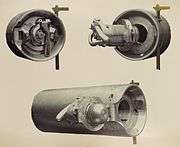De Bange 90 mm cannon
The De Bange 90 mm cannon (Mle 1877) was a type of field artillery piece developed in France by Colonel Charles Ragon de Bange in 1877, and adopted by the French Army that same year. It superseded the earlier Reffye cannon (1870/73) and the Lahitolle 95 mm cannon (1875).
Characteristics
The cannon was breech loading and used the original mushroom-shaped obturator system developed by de Bange, allowing to properly seal the breech during each firing.[1] The cannon lacked a recoil system, meaning that the entire carriage moved backward when fired. Before firing again, the cannon had to be moved back into position and re-aimed, which greatly slowed the effective rate of fire. This would remain a problem with all artillery pieces until the development of the Canon de 75 in 1897.
| Design and operation |
|---|
| A 90mm de Bange artillery piece, in 1898. Painting by Etienne-Prosper Berne-Bellecourt (1838-1910). Musée de l'Armée. |
| Loading and reaiming of the de Bange 90 mm. |
|
Replacement
The de Bange 90 mm was used during World War I, although it was obsolete by then, as there were important stockpiles of ammunition and French industry fell short of producing enough modern cannons for the war.[2] It was superseded by the Canon de 75.
British service
A number of these weapons were issued to some third-line British Territorial Force batteries at the start of World War I, for training and home defence duties, because of a shortage of more modern field guns. They were replaced in these units by Ordnance BLC 15 pounder guns, when second-line units were re-equipped with Ordnance QF 18 pounders.[3][4]
Finnish service
France donated 100 of these cannons in 1940 during Winter War between Finland and Soviet Union. Only 24 guns arrived before the end of the war and rest during the Interim Peace. When Continuation War begun 84 guns were issued to fortification and coastal units. Finnish troops fired more than 174 000 shots with these cannons during Continuation War and last shots in battle were fired as late as in June 1944.[5]
References
- ↑ Field Artillery and Firepower by Jonathan B. A. Bailey, p.208
- ↑ "The French responded to the ammunition crisis in early 1915 by reequipping one hundred batteries with the obsolete '90 de Bange' for which there were large reserve stocks of ammunition" in Field Artillery and Firepower by Jonathan B. A. Bailey, p.245
- ↑ J D Sainsbury, The Hertfordshire Batteries of the Royal Field Artillery, Hart Books, Welwyn, 1996 ISBN 978-0-948527-04-3 (p.93)
- ↑ Appendix 3 in Maj A.F. Becke,History of the Great War: Order of Battle of Divisions, Part 2b: The 2nd-Line Territorial Force Divisions (57th–69th), with the Home-Service Divisions (73rd–74th) and 74th and 75th Divisions, London: HM Stationery Office, 1937/Uckfield: Naval & Military Press, 2007, ISBN 1-847347-39-8.
- ↑
|
|---|
|
- 80 mm (field cannon, 1877)
- 90 mm (field cannon, 1877)
- 120 L (siege cannon, 1878)
- 155 L (siege cannon, 1877)
- 155 C (short cannon, 1881)
- 220 mm (siege mortar, 1880)
- 270 mm (siege mortar, 1885)
- 240 mm (coastal gun, 1884)
|



